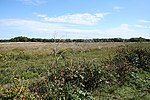West Anstey
Civil parishes in DevonDevon geography stubsNorth DevonVillages in Devon

West Anstey is a village and civil parish on the River Yeo, about 5 miles west of Dulverton, in the North Devon district, in the county of Devon, England. In 2011 the parish had a population of 163. The parish touches Molland, East Anstey and Withypool and Hawkridge.
Excerpt from the Wikipedia article West Anstey (License: CC BY-SA 3.0, Authors, Images).West Anstey
Badlake Lane, North Devon West Anstey
Geographical coordinates (GPS) Address Nearby Places Show on map
Geographical coordinates (GPS)
| Latitude | Longitude |
|---|---|
| N 51.035009 ° | E -3.6385427 ° |
Address
Badlake Lane
EX36 3PE North Devon, West Anstey
England, United Kingdom
Open on Google Maps










